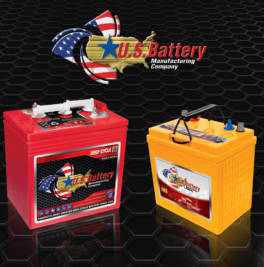The main design difference between FLA and AGM batteries is how the electrolyte is managed. In FLA batteries, the battery plates are submerged in the liquid electrolyte. During use, water in the electrolyte is broken down into oxygen and hydrogen gases and water is lost.
Understanding the Differences Between AGM And Flooded Deep-Cycle Batteries
Dan Sanchez | US Battery Mfg. Co.
When it comes to powering electric vehicles like golf carts, deep-cycle lead-acid batteries are the industry standard. The reason is that they are designed to provide the most cost-effective energy storage and delivery over the life of the battery.
Over the years, there have been two main types of deep-cycle lead-acid batteries that many golf car owners and fleets have used, the Flooded Lead-Acid (FLA) battery and the Absorbed Glass Mat (AGM) battery. While both provide optimum performance in a wide variety of applications, their design difference can offer various advantages depending on the application.
Engineering
The main design difference between FLA and AGM batteries is how the electrolyte is managed. In FLA batteries, the battery plates are submerged in the liquid electrolyte. During use, water in the electrolyte is broken down into oxygen and hydrogen gases and water is lost. This requires regular additions of water to be replaced to keep the battery plates fully submerged in the electrolyte.

In AGM batteries, the electrolyte is absorbed in special glass mat separators that retain all the electrolyte needed for the life of the battery. Since there is no free electrolyte, the oxygen generated on a charge is recombined at the negative plate. In normal operation, hydrogen is not generated and no water is lost. This eliminates the need to add water and also allows the battery to be sealed with a one-way valve that prevents leakage of the electrolyte.
Performance Differences
FLA batteries have been used in a wide variety of applications for well over 150 years. Their popularity comes from their safety, reliability, and cost-effectiveness when compared with other types of rechargeable batteries. According to Fred Wehmeyer, U.S. Battery Senior VP of Engineering, FLA batteries deliver the lowest cost per watt-hour both in acquisition cost and in overall cost per charge/discharge cycle. “This is why they are the best choice for fleets of vehicles or equipment that are used heavily on a daily basis,” says Wehmeyer. “Also, both FLA and AGM batteries offer an environmental advantage over other types of batteries because they are essentially 100 percent recyclable and enjoy the highest recycling rate of any commercial product.”
AGM batteries offer the advantage of being maintenance-free. This can be significant in applications where regular maintenance is difficult or costly, such as when the batteries are located in remote or hard to access locations. Even though AGM batteries cost more per watt-hour, the elimination of maintenance costs reduces the overall battery operational costs. Also, since the battery is sealed and does not emit gases in normal use, it can be used in sensitive areas such as food or pharmaceutical storage facilities.
Selecting between FLA or AGM deep cycle batteries ultimately depends on the type of use and the capability to provide regular maintenance in the application.
AGM = No Maintenance + Higher Cost + Susceptible to abuse like overcharging
FLA = Requires Watering + Lower Cost + Susceptible to abuse from poor maintenance
No matter what type of battery you use, it is always best to target the depth of discharge to 50 percent or less for both FLA or AGM battery types. This will optimize battery life cycle cost vs acquisition cost over the life of the battery system.
The content & opinions in this article are the author’s and do not necessarily represent the views of AltEnergyMag

US Battery
U.S. Battery Manufacturing Company
Other Articles
The Truth About Reviving Dead Batteries
Battery Recycling Can Lead to a Better Future for Energy Resources
Understanding the Chemistries of Deep-Cycle Batteries
More about US Battery
Comments (0)
This post does not have any comments. Be the first to leave a comment below.
Featured Product

